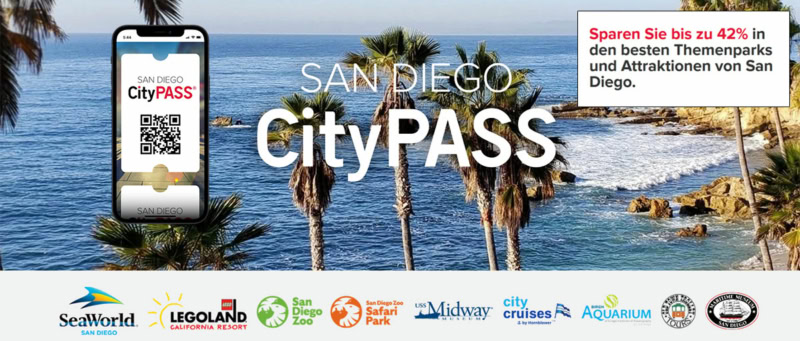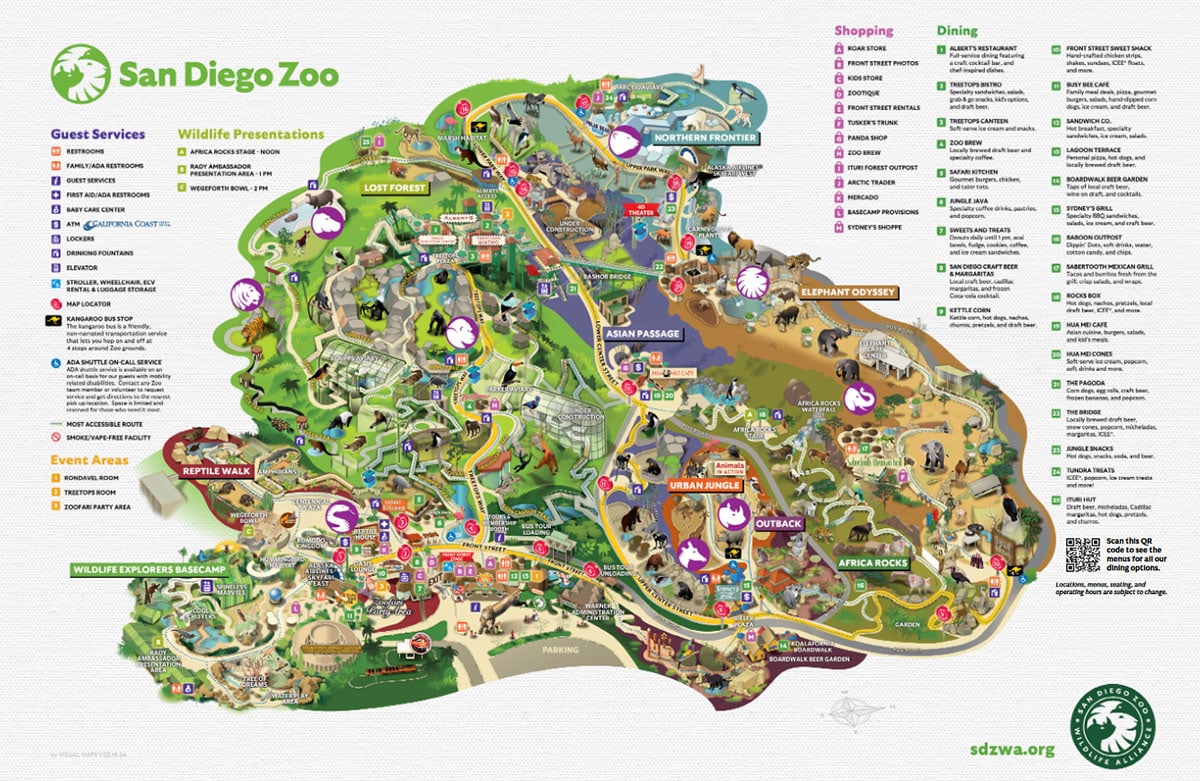On our first day of vacation in San Diego, we planned something really nice: a visit to the San Diego Zoo. We had already heard a lot of positive things about the zoo beforehand, including that it is said to be one of the most beautiful zoos in the world. We have already visited many zoos around the world, such as Miami Zoo, Ueno Zoo in Tokyo, Opel Zoo near Frankfurt, Singapore Zoo and Loro Parque on Tenerife, and were really excited to see how we would like San Diego Zoo.

Table of contents
Things to know about San Diego Zoo
Opened in 1916, the San Diego Zoo is located in Balboa Park, just a few minutes from downtown San Diego, and covers an area of over 40 hectares (location in Google Maps). With around 4 million visitors a year, it is the most visited and best-known zoo in the United States. According to the international TripAdvisor ranking, it has been one of the most beautiful zoos in the world since the early 1990s. The zoo is home to more than 12,000 rare and endangered animals, representing over 680 species and subspecies. The zoo is also a recognized botanical garden, where more than 700,000 individual plants are cultivated.
Under the umbrella of the international non-profit conservation organization ‘San Diego Zoo Wildlife Alliance’, there is the San Diego Zoo and the San Diego Zoo Safari Park, which is located in Escondido, about 50 kilometers or 30 minutes by car northeast of downtown San Diego. The two zoos are not only places where you can observe animals, but are also a center for species conservation and research into animal species. The San Diego Zoo Wildlife Alliance is actively involved in the conservation of endangered species and runs various programs to breed and protect endangered animals.
For years, one of the zoo’s main attractions were the giant pandas, which were on loan from the People’s Republic of China. In 2019, the last two pandas were flown back to their home country, so there have been no more pandas at San Diego Zoo since then. However, at the beginning of 2024, the zoo announced that two new pandas will make their way from China to San Diego at the end of 2024: Yun Chuan and Xin Bao.
Fun fact: In 2005, Jawed Karim, one of the co-founders of YouTube, recorded the world’s first YouTube video at the San Diego Zoo.
As a visitor, you can explore the zoo in different ways. The most individual way is to simply walk through the park at your own pace and discover the different animals. There are also guided tours, for example, where you can learn more about the animals and their habitats, as well as special events and demonstrations that take place every day. There are also several restaurants and cafés in the zoo where you can take a break and enjoy some refreshments.
Tickets via San Diego CityPASS®
On the San Diego Zoo website you can buy a 1-day ticket for 74 USD (for visitors aged 12 and over) or 64 USD (children aged between 3 and 11). As a family with two children, you already pay USD 276 for admission alone and haven’t even eaten or drunk anything. It is often the case in the USA that you pay extra for parking at such parks. However, this is not the case at San Diego Zoo – parking is free.
If you are planning to visit other sights in San Diego anyway, then the San Diego CityPASS®, which we had for exploring the city, is definitely worthwhile. With this sightseeing pass, you can visit all the sights included for a low fixed price, saving you time and money.
The pass can be easily purchased via the CityPASS website or from GetYourGuide. The price includes admission to 3 attractions (San Diego Zoo or Safari Park, USS Midway Museum, City Cruises, Birch Aquarium, Old Town Trolley Tours, Maritime Museum of San Diego) as well as tickets to SeaWorld San Diego, LEGOLAND California or both. We had the largest ticket package, i.e. LEGOLAND + SeaWorld + 3 attractions, for EUR 240 per adult and EUR 220 for children aged 3 and over. Depending on which attractions you visit, you can save up to 42% (compared to buying them individually).
Map of the San Diego Zoo
On the following map you can see very clearly how huge the zoo is. It’s definitely worth getting there first thing in the morning so that you have the whole day to explore and don’t have to rush. A map of the San Diego Zoo can be downloaded here free of charge as a .pdf.
The different themed areas of the zoo
We first familiarized ourselves with the overview map right at the entrance to the San Diego Zoo and saw that there are several large themed areas that we wanted to explore. We started in the eastern part of the park and walked into almost every area from there. As we were still very tired from the long flight and the time difference the day before and therefore took our time exploring the zoo, we didn’t get to see all the animals for a long time.
Africa Rocks
The Conrad Prebys Africa Rocks area offers visitors the opportunity to discover the flora and fauna of the African continent. You will cross six different habitats from the seashore to the savannah and see some of Africa’s most extraordinary species, such as the African Penguin from the Cape Fynbos, lemurs from the Madagascar Forest, a Dwarf Crocodile from the West African Forest, leopards from the Acacia Woodlands, Hamadryas Baboon from the Ethiopian Highlands or a Rock Hyrax and Klipspringer.
We stood with the Baboons for a really long time because they were really active at the time and sometimes played or fought with each other. The monkeys’ enclosure was very spacious and open – we really liked that.
Elephant Odyssey
We were able to observe elephants up close in the Elephant Odyssey area. There are various enclosures and habitats here that have been modeled on the elephants’ natural living conditions. Here, the elephants – which are the largest land mammal in the world – have enough space to move freely and display their natural behavior. And what do elephants like to do best? Eat! And that for up to 16 hours a day. They can easily consume up to 150 kilograms of food, including plants such as grasses, leaves, shrubs, bark and trees.
Northern Frontier
In the Northern Frontier area, you can see a variety of animals that are native to the coolest regions of the world. One of the main attractions in the area is the polar bear enclosure. Here we were able to watch these majestic animals swimming, playing and resting at close range. We found that totally impressive.
Asian Passage
In the Asian Passage, visitors can explore the diversity of the Asian animal world. Here you can discover various enclosures where animals such as bears, tigers, crocodiles and many other species live.
Urban Jungle
The Urban Jungle is home to a variety of animals surrounded by lush vegetation, including a small herd of Masai giraffes, red kangaroos, gazelles, American flamingos, zebras, donkeys and Indian rhinos.
Outback
One of our highlights at the zoo were the koalas in the Australian Outback area. The cute marsupials climb around in the trees or sleep comfortably and totally relaxed in the branches. Simply sweet as sugar! On our walk through the outback we also saw cockatoos, kookaburras (a bird whose call sounds like a loud, hysterical laugh) and wallabies.
Lost Forest
The Lost Forest area is reminiscent of a tropical rainforest and is home to a variety of exotic plants and animals. Here you can see monkeys frolicking in the treetops and exotic birds flying through the air. We also spotted hippos, cheetahs, crocodiles and tapirs here. The flora here is just as impressive as the fauna: dense greenery, tall trees with lianas, unique plants, colorful orchids and dense fern forests.
Wildlife Explorers Basecamp & Skyfari
The Wildlife Explorers Basecamp, built on the site of the former Children’s Zoo, features new and innovative elements, including eight buildings and habitats spread across four different habitat zones: Rainforest, Wild Forest, Swamp Meadows and Desert Dunes. Here you can observe unusual species such as leaf-cutter ants and orb-weaver spiders or prairie dogs and sloths. For children, there are interactive play options, oversized animal-themed sculptures and a unique floating, three-meter-high stone globe that rotates on a thin layer of water. There is definitely a lot for the little ones to discover here. We only discovered the area at the end of the day and unfortunately didn’t have enough time to explore it in depth.
Another highlight at the San Diego Zoo was the ride on the Skyfari Aerial Tram(included in the admission price), which is sponsored by Alaska Airlines. The cable car has been in operation since 1969 and offers visitors a unique perspective of the zoo and the surrounding Balboa Park as they soar over the treetops to the other end of the zoo.
Can we recommend a visit to the San Diego Zoo?
Definitely YES! 🙂 We can absolutely understand why it is regularly voted one of the most beautiful zoos in the world. For us too, it is one of the most beautiful zoos we have ever been to. We particularly liked the spacious enclosures, the natural boundaries between humans and animals and the extensive greenery throughout the facility. At 74 USD, the entrance fee is very high, but it’s really worth it.


